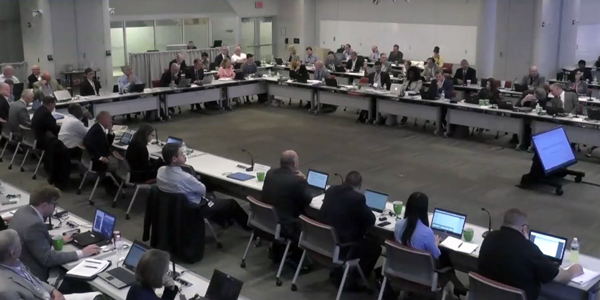Seasonal Aggregation
VALLEY FORGE, Pa. — PJM stakeholders at last week’s meeting of the Markets and Reliability and Members committees unanimously endorsed proposed revisions for aggregating seasonal resources.
PJM’s Andrea Yeaton presented the revisions, which would allow for dispatching resources individually based on their seasonal ability but account for them cumulatively for the purposes of Capacity Performance. (See “Seasonal Aggregation,” PJM Market Implementation Committee Briefs: July 11, 2018.)
Independent Market Monitor Joe Bowring reiterated a request that the rules be amended to explicitly state that PJM has the authority and ability to call on resources without calling all resources in a zone and does not have to schedule the dispatch a day ahead.
“I think it’s less than clear” in the current language, Bowring said.
Default Details
PJM’s Suzanne Daugherty announced that the RTO submitted a request to FERC for waiver of rules requiring staff to liquidate “the large [financial transmission rights] portfolio of a recently defaulted PJM member.” The waiver would “reduce [PJM’s] liquidation of GreenHat’s portfolio to only the portion of the FTR portfolio that is about to become effective for the next calendar month, for each monthly auction for the period from the FTR auction conducted in July until the FTR auction conducted in October” (ER18-2068).
Staff had planned to liquidate the FTR positions in a way that minimizes the resulting burden on all other market participants, who will end up covering the remaining defaulted amount. (See “Credit and Default,” PJM MRC/MC Briefs: June 21, 2018.)
However, PJM said in its filing that it “has encountered adverse pricing effects of attempting to maximize the liquidation of this portfolio irrespective of price,” specifically in the most recent auction that closed on July 27.
“For periods with less liquidity … this large portfolio in combination with PJM’s obligation to offer a price designed to maximize the likelihood of liquidation, irrespective of a price floor, would essentially cause the prices to significantly diverge from the expected day-ahead price outcomes,” PJM said. “An unbounded liquidation of a large FTR portfolio for periods with less liquidity can and will cause a market disruption event and result in distorted market outcomes that may be unjust and unreasonable.”
The waiver “will provide PJM with time to further communicate with stakeholders regarding the concerns of the current Tariff-imposed liquidation process given the significant default allocations that will be incurred under the current liquidation process and to discuss any alternative liquidation process the PJM members may prefer be applied after the FTR auction conducted in October.”
Fuel Security
Because the MRC and MC ran late, a special MRC meeting scheduled to follow the meetings was postponed. A meeting of the now-sunset Transmission Replacement Process Senior Task Force was scheduled for July 31, so staff moved the fuel security session to that time slot. Staff plan to announce they have almost completed the base case for studying the impacts on the system from several fuel-security related contingencies, such as extreme cold weather or gas pipeline interruptions.
Manual Revisions Approved
Stakeholders endorsed by acclamation several manual revisions and other operational changes:
- Manual 3A: Energy Management System (EMS) Model Updates and Quality Assurance (QA). Revisions developed to include or update technical specifications and procedures.
- Manual 14A: New Services Requests Study Process and Manual 14G: Generation Interconnection Requests. PJM sought to split out part of Manual 14A into a new Manual 14G to better organize interconnection information. (See “Interconnection Procedure Split,” PJM PC/TEAC Briefs: June 7, 2018.)
- Manual 11: Energy & Ancillary Services Market Operations. Revisions developed to address inconsistencies between PJM’s governing documents regarding price-based offers above $1,000. PJM plans to introduce additional system controls to improve validation of price-based offers by November. (See “Energy Market Caps,” PJM Market Implementation Committee Briefs: July 11, 2018.)
- Revisions to the Reliability Assurance Agreement and Manual 18 associated with changes developed by the Demand Response Subcommittee to address issues identified with atypically low customer load during the winter peak load (WPL) calculation period. The Market Implementation Committee endorsed the changes in June. The proposal would use measurement and verification processes that already exist for a similar process and minimize administrative adjustments. It would define “low usage” days as less than 35% of the five-day WPL average and allow the exclusion of up to two such days from the WPL calculation. The measure was also endorsed at the MC via the consent agenda. (See “Now is the Winter of Our Discontent (with DR Rules),” PJM Market Implementation Committee Briefs: Sept. 13, 2017.)
- Tariff revisions to implement a 10-cent/MWh minimum monthly credit requirement for FTR bids submitted in auctions and cleared positions held in FTR portfolios. Staff announced they will move the effective date up from October to Sept. 3. The measure was also endorsed at the MC via the consent agenda. (See “Credit Requirements,” PJM Market Implementation Committee Briefs: July 11, 2018.)
- Problem statement and issue charge setting black start fuel requirements, which include pushing the anticipated start date for the stakeholder group back a month to December. Staff also added “critical non-fuel consumables” to the list of requirements to develop and minimum tank suction level to compensation-related issues to hash out. The measure was unanimously endorsed, but several stakeholders voiced concerns with adding another issue to the agenda when many have already expressed concerns about overscheduling. (See “Black Start Fuel Assurance,” PJM Operating Committee Briefs: July 10, 2018.)
— Rory D. Sweeney




